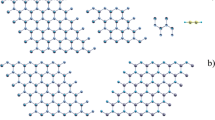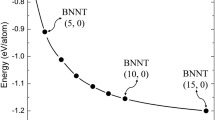Abstract
Spin-polarized first-principles total-energy calculations have been performed to investigate the possible chain reaction of acetylene molecules mediated by hydrogen abstraction on hydrogenated hexagonal boron nitride monolayers. Calculations have been done within the periodic density functional theory (DFT), employing the PBE exchange correlation potential, with van der Waals corrections (vdW-DF). Reactions at two different sites have been considered: hydrogen vacancies on top of boron and on top of nitrogen atoms. As previously calculated, at the intermediate state of the reaction, when the acetylene molecule is attached to the surface, the adsorption energy is of the order of −0.82 eV and −0.20 eV (measured with respect to the energy of the non interacting molecule-substrate system) for adsorption on top of boron and nitrogen atoms, respectively. After the hydrogen abstraction takes place, the system gains additional energy, resulting in adsorption energies of −1.52 eV and −1.30 eV, respectively. These results suggest that the chain reaction is energetically favorable. The calculated minimum energy path (MEP) for hydrogen abstraction shows very small energy barriers of the order of 5 meV and 22 meV for the reaction on top of boron and nitrogen atoms, respectively. Finally, the density of states (DOS) evolution study helps to understand the chain reaction mechanism.

Acetylene chain reaction on hydrogenated boron nitride monolayers







Similar content being viewed by others
References
Giovannetti G, Khomyakov PA, Brocks G, Kelly PJ, van den Brink J (2007) Substrate induced band gap in graphene on hexagonal boron nitride: ab initio density functional calculations. Phys Rev B 76:073103
Dean CR, Young AF, Meric I, Lee C, Wang L, Sorgenfrei S, Watanabe K, Taniguchi T, Kim P, Shepard KL, Hone J (2010) Boron nitride substrates for high-quality graphene electronics. Nat Nanotech 5:722–726
Zou X, Huang C, Wang L, Yin L, Li W, Wang J, Wu B, Liu Y, Yao Q, Jiang C, Wu W, He L, Chen S, Ho JC (2016) Dielectric engineering of a boron nitride/hafnium oxide heterostructure for high-performance 2D field effect transistors. Adv Mater 28:2062–2069
Lee TH, Kim K, Kim G, Park HJ, Scullion D, Shaw L, Kim M, Gu X, Bae W, Santos EJG, Lee Z, Shin HS, Nishi Y, Bao Z (2017) Chemical vapor-deposited hexagonal boron nitride as a scalable template for high-performance organic field-effect transistors. Chem Mater 29:2341–2347
Li LH, Santos EJG, Xing T, Cappelluti E, Roldan R, Chen Y, Watanabe K, Taniguchi T (2015) Dielectric screening in atomically thin boron nitride nanosheets. Nano Lett 15:218–223
Lee KH, Shin H, Lee J, Lee I, Kim G, Choi J, Kim S (2012) Large-scale synthesis of high-quality hexagonal boron nitride nanosheets for large-area graphene electronics. Nano Lett 12:714–718
Lei W, Portehault D, Liu D, Qin S, Chen Y (2013) Porous boron nitride nanosheets for effective water cleaning. Nat Commun 4:1777
Li J, Xiao X, Xu X, Lin J, Huang Y, Xue Y, Jin P, Zou J, Tang C (2013) Activated boron nitride as an effective adsorbent for metal ions and organic pollutants. Sci Rep 3:3208
Jia S, Wang Z, Ding N, Wong Y-LE, Chen X, Qiu G, Chan T-WD (2016) Hexagonal boron nitride nanosheets as adsorbents for extraction of polychlorinated biphenyls from water samples. Anal Chim Acta 936:123–129
Khan MH, Jamali SS, Lyalin A, Molino PJ, Liang L, Liu HK, Taketsugu T, Huang Z (2017) Atomically thin hexagonal boron nitride nanofilm for cu protection: the importance of film perfection. Adv Mater 29:1603937
Zhang J, Yang Y, Lou J (2016) Investigation of hexagonal boron nitride as an atomically thin corrosion passivation coating in aqueous solution. Nanotechnology 27:364004
Lipp A, Schwetz A, Hunold K (1989) Hexagonal boron nitride: fabrication, properties and applications. J Eur Ceram Soc 5:3–9
Chen X, Wu P, Rousseas M, Okawa D, Gartner Z, Zettl A, Bertozzi CR (2009) Boron nitride nanotubes are noncytotoxic and can be functionalized for interaction with proteins and cells. J Am Chem Soc 131:890–891
Lin S, Ye X, Johnson RS, Guo H (2013) First-principles investigations of metal (cu, ag, au, Pt, Rh, Pd, Fe, co, and Ir) doped hexagonal boron nitride Nanosheets: stability and catalysis of CO oxidation. J Phys Chem C 117:17319–17326
Tang S, Cao Z (2010) Structural and electronic properties of the fully hydrogenated boron nitride sheets and nanoribbons: insight from first-principles calculations. Chem. Phys. Lett 488:67–72
Ponce-Pérez R, Cocoletzi GH (2017) Hydrogenated boron nitride monolayer functionalization: a density functional theory study. Comp Theor Chem 1111:33–39
Castro-Medina J, Garcia-Total D, Lopez-Fuentes M, Sanchez-Castillo A, Torres-Morales S, Morales de la Garza L, Cocoletzi GH (2017) Thymine adsorption on two-dimensional boron nitride structures: first-principles studies. J Mol Model 23:109
Hernandez JMG, Cocoletzi GH, Anota EC (2012) DFT studies of the phenol adsorption on boron nitride sheets. J Mol Model 18:137–144
Ponce-Pérez R, Cocoletzi GH, Takeuchi N (2016) Two-dimensional boron nitride structures functionalization: first principles studies. J Mol Model 22:226
Rubioz.Pereda P, Takeuchi N (2013) Density functional theory study of the organic functionalization of hydrogenated silicene. J Chem Phys 138:194702
Rubio-Pereda P, Takeuchi N (2013) Density functional theory study of the organic functionalization of hydrogenated graphene. J. of Phys. Chem. C 117:18738–18745
Rubio.Pereda P, Takeuchi N (2015) Adsorption of organic molecules on the hydrogenated germanene: a DFT study. J Phys Chem C 119:27995–28004
Giannozzi P et al (2009) Quantum ESPRESSO: a modular and open-source software project for quantum simulations of materials. J Phys Condens Matter 21:395502
Dion M, Rydberg H, Schroder E, Langreth DC, Lundqvist BI (2004) Van der Waals density functional for general geometries. Phys Rev Lett 92:246401
Thonhauser T, Cooper VR, Li S, Puzder A, Hyldgaard P, Langreth DC (2007) Van der Waals density functional: self-consistent potential and the nature of the van der Waals bond. Phys Rev B 76:125112
Roman-Pérez G, Soler JM (2009) Efficient implementation of a van der Waals density functional: application to double-wall carbon nanotubes. Phys Rev Lett 103:096102
Vanderbilt D (1990) Soft self-consistent pseudopotentials in a generalized eigenvalue formalism. Phys Rev B 11:7892
Perdew JP, Burke S, Ernzerhof M (1996) Generalized gradient approximation made simple. Phys Rev Lett 77:3865
Methfessel M, Paxton AT (1989) High precision sampling for Brillouin-zone integrations in metals. Phys Rev B 40:3616
Monkhorst HJ, Pack JD (1976) Special points for Brillouin-zone integrations. Phys Rev B 13:5188
Henkelman G, Uberuaga BP, Jonsson H (2000) A climb image nudged elastic band method for finding saddle points and minimum energy paths. J Chem Phys 113:9901
Henkelman G, Jonsson H (2000) Improved tangent estimate in the nudge elastic band method for finding minimum energy paths and saddle points. J Chem Phys 113:9978
Jiang DE, Carter EA (2004) Adsorption, diffusion, and dissociation of H2S on Fe(100) from first principles. J Phys Chem B 108:19140
Acknowledgments
G.H.C. acknowledges the financial support of VIEP-BUAP grant HECG-EXC16-1, CONACYT project ##223180, and Cuerpo Académico Física Computacional de la Materia Condensada (BUAP-CA-194). N.T. thanks CONACYT Project 281052 and DGAPA-UNAM project IN100516 for partial financial support. Calculations were performed in the DGTIC-UNAM supercomputing center, project LANCAD-UNAM-DGTIC-051, Instituto de Física BUAP and LNS-BUAP.
Author information
Authors and Affiliations
Corresponding author
Rights and permissions
About this article
Cite this article
Ponce-Pérez, R., Cocoletzi, G.H. & Takeuchi, N. Acetylene chain reaction on hydrogenated boron nitride monolayers: a density functional theory study. J Mol Model 23, 359 (2017). https://doi.org/10.1007/s00894-017-3536-0
Received:
Accepted:
Published:
DOI: https://doi.org/10.1007/s00894-017-3536-0




